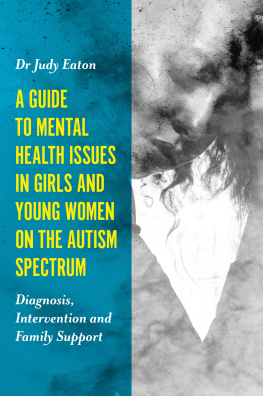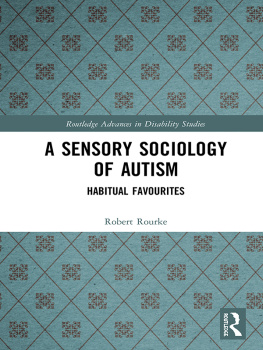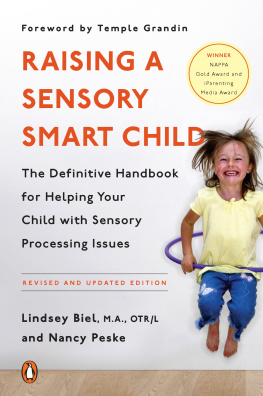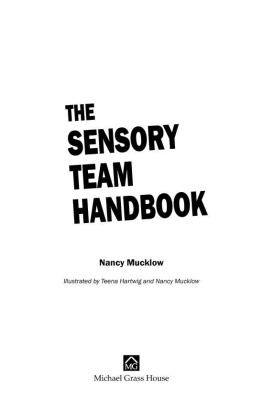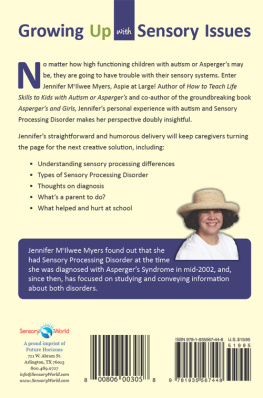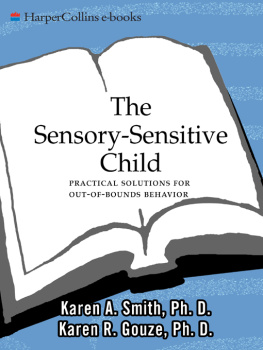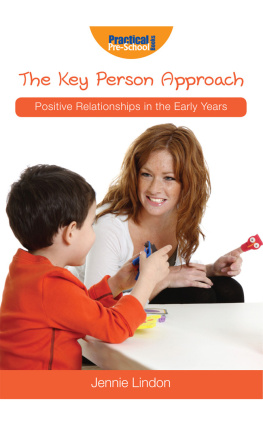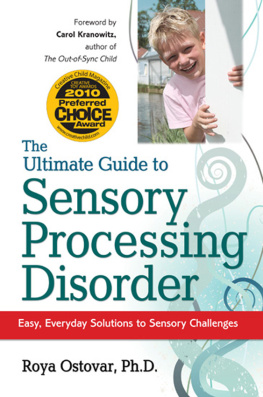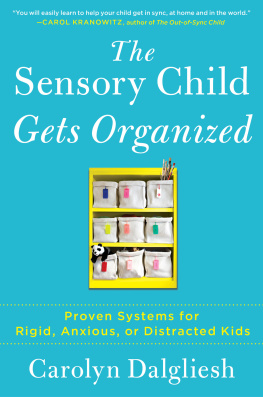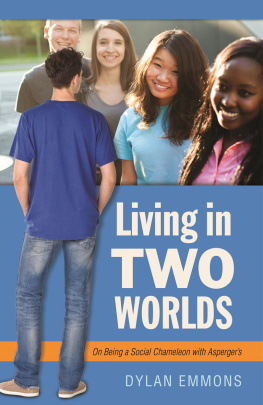Far too often, adults with autism and their experiences seem to be ignored or misunderstood. This book is refreshingly different, bringing interesting new perspectives to the under-explored area of sensory issues in adults. It is written in a way that makes complex topics accessible and, perhaps more importantly, conveys a sense of respect for adults on the spectrum (which is sorely lacking in many texts!). A must-read for adults on the spectrum and those who support them.
Kirsten Hurley, Programme Coordinator, Autism Studies, University College Cork
Diarmuid has had one of the biggest impacts on my life. Having Aspergers has affected me in different ways, ranging from the sensory aspects to the social aspects. My life has completely changed for the better, and the help I have received from Diarmuid has been outstanding. I would recommend this book for anyone on the autism spectrum.
Cian Hutt, student with Aspergers syndrome
of related interest
Sensory Perceptual Issues in Autism and Asperger Syndrome
Second Edition
Different Sensory Experiences Different Perceptual Worlds
Olga Bogdashina
Foreword by Manuel Casanova
ISBN 978 1 84905 673 1
eISBN 978 1 78450 179 2
Older Adults and Autism Spectrum Conditions
An Introduction and Guide
Wenn Lawson
Foreword by Carol Povey
ISBN 978 1 84905 961 9
eISBN 978 0 85700 813 8
Marriage and Lasting Relationships with Aspergers Syndrome (Autism Spectrum Disorder)
Successful Strategies for Couples or Counselors
Eva A. Mendes
Foreword by Stephen M. Shore
ISBN 978 1 84905 999 2
eISBN 978 0 85700 981 4
Life on the Autism Spectrum A Guide for Girls and Women
Karen McKibbin
Foreword by Tony Attwood
ISBN 978 1 84905 747 9
eISBN 978 1 78450 193 8
SENSORY
ISSUES
FOR ADULTS WITH
AUTISM
SPECTRUM
DISORDER
DIARMUID HEFFERNAN

Jessica Kingsley Publishers
London and Philadelphia
First published in 2016
by Jessica Kingsley Publishers
73 Collier Street
London N1 9BE, UK
and
400 Market Street, Suite 400
Philadelphia, PA 19106, USA
www.jkp.com
Copyright Diarmuid Heffernan 2016
All rights reserved. No part of this publication may be reproduced in any material form (including photocopying or storing it in any medium by electronic means and whether or not transiently or incidentally to some other use of this publication) without the written permission of the copyright owner except in accordance with the provisions of the Copyright, Designs and Patents Act 1988 or under the terms of a licence issued by the Copyright Licensing Agency Ltd, Saffron House, 610 Kirby Street, London EC1N 8TS. Applications for the copyright owners written permission to reproduce any part of this publication should be addressed to the publisher.
Warning: The doing of an unauthorised act in relation to a copyright work may result in both a civil claim for damages and criminal prosecution.
Library of Congress Cataloging in Publication Data
Heffernan, Diarmuid.
Sensory issues for adults with autism spectrum disorder / Diarmuid Heffernan.
pages cm
Includes bibliographical references and index.
ISBN 978-1-84905-661-8 (alk. paper)
1. Autism spectrum disorders. 2. Perceptual disorders. I. Title.
RC553.A88H44 2016
616.85882--dc23
2015031395
British Library Cataloguing in Publication Data
A CIP catalogue record for this book is available from the British Library
ISBN 978 1 84905 661 8
eISBN 978 1 78450 212 6
CONTENTS
FOREWORD
Dr Luke Beardon
It was about twenty years ago that I became obsessively fascinated around the sensory differences experienced by people with autism, after having met an individual for whom the feeling of drops of water on his skin was intolerable. Finally, in 2013, DSM-5 included sensory processing in the diagnostic criteria. And yet, in the main, the world of sensory processing remains one which does not have the level of exploration that is required in order to best understand the autistic experience. Some authors, notably Olga Bogdashina and Brenda Smith Myles, have gone a long way towards advancing knowledge in this area; Diarmuid has added to the literature with his rich, in depth, accessible book which is full of beneficial information for people with autism, families, and professionals.
It is incredibly difficult, unless one experiences sensory differences oneself, to appreciate just how impactful the sensory world can be. For many people with autism, it is the sensory reality that can so often impinge on how they live their lives. Many individuals will report that their way of perceiving the sensory world - both in a positive and negative way - leads to an array of behaviour that is frequently misunderstood. Without an intuitively empathic way of understanding sensory profiles, anyone involved with an autistic individual who is influenced by the sensory environment will need some other way of appreciating the autistic experience. Sometimes, the individual (him/herself) will be the best person to develop understanding. At other times, however, it may be necessary to look elsewhere.
In his book, Diarmuid manages to explain what is a hugely complicated subject area in a way that is eminently readable and informative. He bridges the gap between science and the lived experience extremely well, with a healthy dose of suggested ways in which individuals might be supported.
I frequently meet individuals who report their sensory experiences fantastically well, enabling me to accept why it might be so problematic to walk down a busy street, or have a hug, or wear a certain colour of clothes (the list, while not endless, could go on, and on); this does not mean I have a genuine understanding of these things, but at least knowledge of them helps me to accept them. While Diarmuids book also explores the myriad of ways an autistic person might experience the world, he also provides some excellent theory, which supports his rationales and real life examples.
I am as obsessed now as I was those two decades ago, so I was full of excited anticipation when asked to read Diarmuids book and write a foreword. I am very pleased that my excitement was well justified; this is an excellent read, and one which I would recommend to anyone with an interest in autism and the sensory world.
Dr Luke Beardon
ACKNOWLEDGEMENTS
I would like to acknowledge and thank a number of people who played a role in supporting this book to fruition. To Natalie, Suzanne and Emma and previously Sarah from Jessica Kingsley for their patience and support. Thanks to Emily who originally showed faith in my ideas. A particular thank you to my brother in arms Dave who has been a great friend and a great sounding board throughout this project and throughout most of my life. Thanks also to Kerry for fulfilling a similar role closer to home. Thanks to Graham for the many helpful chats and to Darragh for his very practical help. My thanks to the Cronin family for their support.
Thanks to Luke for agreeing to be part of this project and also for offering insightful suggestions. I owe a debt of gratitude to Kirsten for being a constant source of support and for spurring me on when my energy flagged.
A particular thanks to the Heffernan family especially Sean and Kit, and thank you Kit for instilling my love of reading.
This book would not have been written without the contributions of a number of people that provided interviews which were integral to the book and were also a source of inspiration for wanting to write in the first instance. The humour, patience and honesty shown by all made the writing process all the easier and more enjoyable.
Next page

